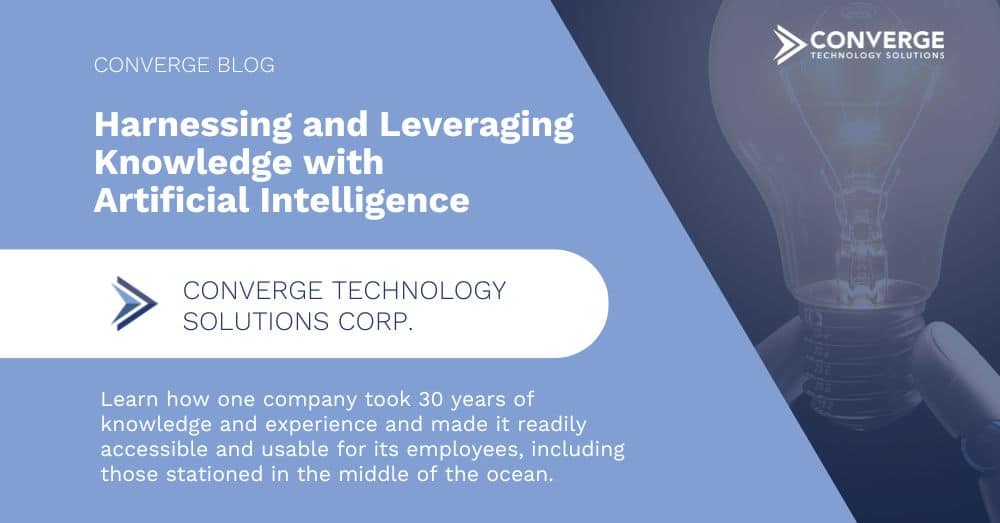How one company took 30 years of knowledge and experience and made it readily accessible and usable for its employees, including those stationed in the middle of the ocean.
The term brain dump was first used in 1985. Merriam-Webster defines it as “the act or an instance of comprehensively and uncritically expressing and recording one’s thoughts and ideas (as on a particular topic).” Brain dumps are easy and routine. The ability to upload one’s thoughts and knowledge to a database has been the stuff of science fiction for nearly as long. While we are still hundreds of years away from “mind uploading” as this Ted Talk explains, using artificial intelligence (AI) to harness all the intellectual resources and knowledge held within a business and its subject matter experts is technology available now.
One fantastic example of using AI to catalog, index, and leverage knowledge across an organization is Woodside Energy. For over 30 years, Woodside has been operating some of the world’s largest and most complex petroleum and liquefied natural gas (LNG) production platforms. Over three decades, thousands of engineers have developed solutions to both common and obscure problems from design to construction and management of facilities. Naturally, the most tenured and knowledgeable engineers who had been with Woodside since the beginning were nearing retirement.
The Challenge of Preserving Knowledge and Increasing Productivity
Company leaders recognized the value of preserving the knowledge of their subject matter expert engineers and the documentation (the brain dumps) that they had created during their careers. Pairing seasoned engineers with less experienced engineers proved helpful with knowledge sharing but not necessarily efficiency.
According to this IBM case study, “Woodside believed that by improving its employees’ ability to tap into engineering insights that lay hidden and dormant throughout different parts of the organization, it could solve problems faster, reduce costs and drive greater engineering efficiencies. The CEO, therefore, wanted to transform the business from reactive to predictive and from opinion-based to fact-based in its decision making.”
They knew there was a quicker way to impart knowledge and improve productivity across the organization through knowledge sharing. The documentation was certainly there. The company had been archiving their employees’ reports, decision logs, and technical evaluations for decades.
The Process for Preserving Knowledge
To start, the organization worked with IBM to upload approximately 30 years’ worth of documents, or 600,000 pages. According to the IBM case study, “The vast majority of the content—which includes testing data and results, project management reports, and associated correspondence—was in unstructured form. During this phase, advanced text analysis and machine-learning algorithms within Watson Natural Language Classifier and Watson Discovery software scanned all the content to create a web of relationships among data elements.” Watson Assistant software was used to create a better user experience by allowing the IBM Watson solution to interact with Woodside engineers in their own language.
The IBM case study’s accompanying video describes the project this way, “We teach Watson to talk like an engineer. Watson teaches us to think like a thousand engineers from a thousand different sources.”
Practically speaking, this is how it works. As engineers or project managers have questions or encounter issues, they put them in simple question form using a mobile device, laptop, even use robotics to speak into a device. Their questions might be ‘How did we design and select the compressors on the North Rankin II platform? Or what design features do we have in place on the offshore platform to deter birds?’ Those simple questions yield instant results from project teams who have experienced similar issues.
Common Applications for Artificial Intelligence in Businesses
Woodside’s experience with AI, while certainly impressive, may seem out of reach or unrelated to other types of businesses. However, the applications for AI within other types of businesses and industries are many and likely, simpler to implement.
Take customer care, for example. Customer care positions tend to be low-paying, high-volume jobs. Job satisfaction is typically low. Considering that 70% of all contact center costs are related to personnel, the typical 30% turnover rate for customer care employees is costing businesses dearly.
And poor customer care doesn’t just create employee turnover but lost customers as well. Customer care agents solve business problems they haven’t created and rarely have the information and the power to solve. Customer care employees typically struggle to find answers to basic questions, which is largely why 50% of customer calls go unresolved or require escalation. An unresolved question or transferred calls can lead to customers to turn to competitors. Customers don’t generally compare a business’s customer care experience with that of their competitors. They compare it to the best customer care that they have ever received, and if the comparison is unfavorable, they are quick to leave. Another recent trend is for customers to leave when a company can’t meet their communication preferences like text or chat.
Watson Assistant solves many common customer care problems for both customers and employees.
- Customer Self-Service: Watson Assistant can provide AI-powered automated assistance to customers through their preferred web/mobile or voice channels.
- Employee Self-Service: Watson Assistant can support employees 24/7 by providing AI-powered automated assistance through web/mobile or voice channels.
- Agent Assist: Watson Assistant can enable human agents to better handle customer inquiries. Watson Assistant can even listen and suggest.
Watson Discovery is an award winning AI powered intelligent search and text analytics platform that eliminates data silos and retrieves information buried inside enterprise data. It uses innovative, market-leading natural language processing to uncover meaningful business insights from documents, webpages and big data, cutting research time by more than 75%.
- Pinpoints answers: Comb through content in your connected data sources, pinpoint the most relevant passage and obtain the source documents or webpage
- Find trends: Dig through your data in real time to reveal hidden patterns, trends and relationships between different pieces of content. Use text analytics to gain insights into customer and user behavior, analyze trends in social media and e-commerce, find the root causes of problems to inform decision making, and more
- Better chatbots: Improve customer experience with Watson Assistant’s Search Skill so your virtual assistant can provide answers from your documents and data in a conversational search experience
Watson Natural Language Classifier makes text classification easy.
- Allows developers to quickly and easily build custom text classification models without the need for a data science or machine learning background.
- Quickly trains custom machine learning models to analyze and label textual data
- Identify next best actions, organize and analyze your data for trends and new insights
- Categorize text data: Automate workflows, extract insights and improve search and discovery with text you can easily categorize
- Evaluate results: Update training data based on classification results to improve your confidence scores
- Train via Tooling or an API: Access capabilities through the API or non-technical tooling in order to build, train and manage classifiers, regardless of your technical skills
All are available on IBM Public Cloud, on-premise, and on cloud (via Cloud Pak for Data) to provide flexibility and meet the compliance and regulatory requirements for enterprises.




